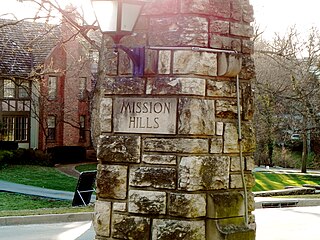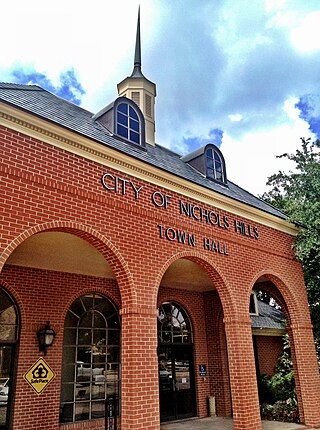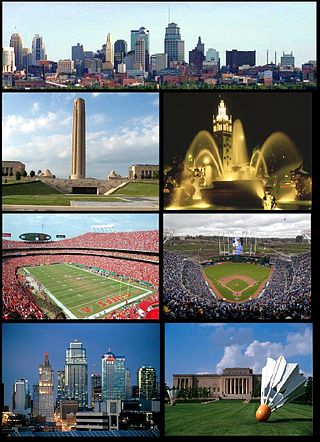
Mission Hills is a city in Johnson County, Kansas, United States, and part of the Kansas City Metropolitan Area. As of the 2020 census, the population of the city was 3,594. The east city limits is the Kansas-Missouri state line at State Line Road. Mission Hills was originally developed by noted Kansas City developer J. C. Nichols beginning in the 1920s as part of his Country Club District plan.

Nichols Hills is a city in Oklahoma County, Oklahoma, United States, and a part of the Oklahoma City metropolitan area. The population was 3,870 as of the 2020 census, a 4.3% increase from 2010.

The Kansas City metropolitan area is a bi-state metropolitan area anchored by Kansas City, Missouri. Its 14 counties straddle the border between the U.S. states of Missouri and Kansas. With 8,472 square miles (21,940 km2) and a population of more than 2.2 million people, it is the second-largest metropolitan area centered in Missouri and is the largest metropolitan area in Kansas, though Wichita is the largest metropolitan area centered in Kansas. Alongside Kansas City, Missouri, these are the suburbs with populations above 100,000: Overland Park, Kansas; Kansas City, Kansas; Olathe, Kansas; Independence, Missouri; and Lee's Summit, Missouri.

Thomas Sturges Watson is an American retired professional golfer on the PGA Tour Champions, formerly on the PGA Tour.

The Country Club Plaza is a privately-owned regional shopping center in the Country Club District of Kansas City, Missouri. Opened in 1923, it was the first planned suburban shopping center and the first regional shopping center to accommodate shoppers arriving by car.

Jesse Clyde "J. C." Nichols was an American developer of commercial and residential real estate in Kansas City, Missouri. Born in Olathe, Kansas, and a student at the University of Kansas and Harvard University, his most notable developments are the Country Club District and Country Club Plaza in Kansas City, which influenced suburban developments in other parts of the United States. He served leadership roles in local and national real estate organizations. Through these organizations, his ideas about real estate and planning helped to shape methods for racist and anti-Semitic restrictive covenants and zoning. His legacy has come under increasing scrutiny for these covenants, which prohibited Blacks, Jews, and other minorities from living in these neighborhoods.

The Pembroke Hill School is a progressive, inclusive, secular, coeducational, independent preparatory school for about 1,200 students in early years through high school, separated into four sections: early years-prekindergarten, kindergarten-5th grade, 6th-8th grade, and 9th-12th grade. It is located on two campuses in the Country Club District of Kansas City, Missouri, near the Country Club Plaza.
Roland Park is a community located in Baltimore, Maryland. It was developed between 1890 and 1920 as an upper-class streetcar suburb. The early phases of the neighborhood were designed by Edward Bouton and Frederick Law Olmsted Jr.
The list of neighborhoods of Kansas City, Missouri has nearly 240 neighborhoods. The list includes only Kansas City, Missouri and not the entire Kansas City metropolitan area, such as Kansas City, Kansas.

Ward Parkway is a boulevard in Kansas City, Missouri, United States. Ward Parkway begins at Brookside Boulevard on the eastern edge of the Country Club Plaza and travels west 2.8 miles along Brush Creek as U.S. Route 56 before turning south near Kansas-Missouri state line. It continues south for 4 miles, terminating at Wornall Road near Bannister Road. A short spur, Brush Creek Parkway, connects Ward Parkway to Shawnee Mission Parkway at State Line Road.
The Country Club District is the name of a group of neighborhoods comprising a historic upscale residential district in Kansas City, developed by noted real estate developer J.C. Nichols. The district was developed in stages between 1906 and 1950, and today is home to approximately 60,000 and includes such well-known Kansas City neighborhoods as Sunset Hill and Brookside in Missouri, Mission Hills, Fairway, and the oldest parts of Prairie Village in Kansas, making it the largest planned community built by a single developer in the United States. Ward Parkway, a wide, manicured boulevard, traverses the district running south from the Country Club Plaza, the first suburban shopping district in the United States.

Seth Edmund Ward was a trader on the California, Oregon and Santa Fe trails who parlayed his success into a real estate empire, some of which is part of today's Country Club District in Kansas City, Missouri.
Main Street or Main is a one of the major streets in Kansas City, Missouri and the Kansas City metropolitan area. Main Street serves as the main administrative dividing line for house numbering and east–west streets in Kansas City; for example, it separates East 59th Street from West 59th Street. Address numbers on east–west streets increase in both directions as one moves away from Main Street. This should not be confused with the Kansas City "East Side" and "West Side," a cultural distinction which has arisen from a history of racist segregation in the city, separated by Troost Avenue approximately 1 mile east of Main Street.

Loose Park is the third largest park in Kansas City, Missouri, located at 51st Street and Wornall Road. It has a lake, a shelter house, Civil War markers, tennis courts, a water park, picnic areas, and a Rose Garden. The Rose Garden hosts all types of outdoor special events including theatrical performances and wedding ceremonies. The Japanese Tea Room and Garden is a small traditional Japanese garden conceived as a cultural exchange between the sister cities of Kurashiki, Japan and Kansas City, Missouri.

The Mission Hills Country Club (MHCC) is a country club and golf course in the Kansas City-area suburb of Mission Hills, Kansas.
Indian Hills Country Club is a private club and golf course in Mission Hills, Kansas.
Wornall Road is a major north–south road in Kansas City, Missouri. It is named for John Bristow Wornall, an early settler of Kansas City, whose estate still stands today as a museum.
Sidney John Hare was an American landscape architect. He worked with his son S. Herbert Hare with the landscaping company Hare & Hare.

Jewish country clubs are country clubs whose members are predominantly Jewish, having been excluded from other elite social clubs during periods of rising anti-Semitism in the late 19th and early 20th centuries. As a result, many major cities across the United States have at least one Jewish country club and, in cities with larger Jewish populations, often more than one, founded by wealthy Jews in that era.













